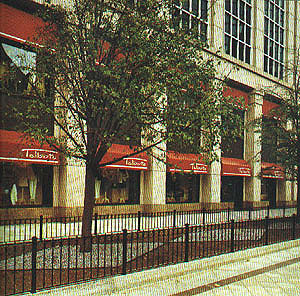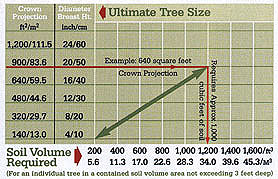      |
| |
|
|
|
|
|
| |
|
| |
|
| Components |
|
| |
|
| Intensely
Urban Situations |
|
| Trees in these areas are confined
to sidewalk planting areas often between building facades and the
street. Often times they are sharing space (usually underground) with
utilities. The planting area is limited: sidewalks need to safely
provide as much room as possible for pedestrians. |
|
| |
|
| 1. Planting Options |
|
|

Figure 1. Example of tree plantings in
an intensely urban setting. Note trench for tree interconnection,
mulch and protective fencing.
|
 |
There is no standard tree planting detail - the conditions
must be assessed for every situation. The most important ingredient
in urban tree planting is proper soil. Trees need as much
soil as possible; an ideal urban situation provides continuous,
interconnected improved soil that is protected from compaction
by surrounded uses. For healthy crown growth, trees should
be spaced approximately 30 - 40 feet apart. (Urban, J., no
date; Figure 1).
Tree trenches provide the interconnected soil that street
trees need for healthy root growth. Planting in linear trenches
also allows trees to form continuous canopies that contribute
to wildlife habitat and shade quality. Trenches to be approximately
6 ft. wide. (Urban, J.)
|
|
|
| |
|
| Disconnected tree pits
for individual trees are not a good design alternative. They do not
provide the continuous soil trees need. If only one tree is being
planted, or there is no other option. |
|
| |
|
| 2. Type of cover around trees |
|
- Do not use tree grates around trees - they are expensive, require
maintenance, and can damage trees if they are not sized and replaced
as the tree grows (Urban, J., no date). Alternatives to tree grates
are mulch, groundcover plants, and pavers. Research indicates
street trees are subject to less damage if they are underplanted
(w/ herbaceous plantings and shrubs) instead of surrounded by
hardscape.
- Mulch is best for all trees and will be addressed below under
Tree Care. Unfortunately, intensely urban situations often are
not suitable for mulch, but may be possible if combined with a
low fence.
- Groundcover plants provide great protection for street trees
because they usually keep pedestrian traffic out of the tree's
root bed. Again, a low fence adds additional protection. Further
opportunities for these understory plantings are discussed in
the "Broken Urban" section.
- Flexible pavers can be used when there is no room to provide
either of the above permeable soil surfaces. Pavers should be
set in wide sand joints leaving at least 1 ft. of space at the
trunk to allow for unimpeded tree growth (Urban, J., no date).
|
|
| |
|
| 3. Soils |
|
| Soil Volume: the graph below provides
soil volume requirements for expected tree crown size at maturity. |
|
| |
|
|

Figure 2. Tree damage in relation to
root surface material
|
 |
Structural Soil
- Trees require loose permeable soils where their roots can
grow and access rainwater or irrigation; however, these needs
are in direct conflict with engineering specifications for compacted
soil beneath roads and sidewalks. Recently, researchers at the
Cornell University Urban Horticulture Institute have developed
a new pavement substrate called "Structural Soil".
This medium has high bearing strength for a stable pavement
surface, but remains root penetrable and supportive of tree
growth. |
|
|
| Structural soil is made of a precise
combination of crushed stone, clay loam and a hydrogel stabilizing
agent (Bassuk, Nina, 1997). (http://www.hort.cornell.edu/department/faculty/bassuk/uhi/pubs.html) |
|
| |
|
| 4. Tree selection |
|
| Trees will live longer,
healthier lives by utilizing compatible site restrictions. For example,
trees planted under utility lines may be topped. If street trees are
planted under utility lines, it is best to choose a species that does
not grow over 25' at maturity. Another alternative is to specify a
plant grouping consisting of only understory shrubs. The City of Seattle
Urban Forest Coalition provides extensive lists of appropriate street
trees for a range of urban situations. The recommendations are divided
into categories based on the width of the planting strip; for example,
very narrow planting areas (less than 5 ft wide) require compact trees
like the Washington hawthorn, Crataegus phaenopyrum. (City of Seattle
Urban Forest Coalition, 1998; http://www.ci.seattle.wa.us/td/treeplant.asp). |
|
| |
|
| 5. Tree care |
|
- Mulching: All newly planted trees are covered with a 2"-
3" layer of mulch to protect the tree base, allowing soil
to retain more water (City of Seattle Urban Forest Coalition,
1998). Mulch also discourages weed growth. Trees need to be weed
and grass free for at least the first two growing seasons (Urban,
J., no date). An 8 ft. diameter spread of mulch around a newly
planted tree will contribute to improved root development (City
of Seattle Urban Forest Coalition, 1998), but in more constricted
planting situations, a minimum 6 ft. diameter is retained. Finally,
always leave an air space between the base of the trunk and the
mulch layer.
- Irrigating - New trees need an established maintenance plan
providing at least 5 gallons of water per inch of tree trunk diameter
for at least the first dry season after planting (City of Seattle
Urban Forest Coalition, 1998). Preferably, new trees should be
watered for the first 3 dry seasons after they are planted. Irrigation
should occur at a slow rate to allow water penetration into soil.
- Staking - Staking is not recommended for new trees. Trees will
not need staking if they are planted so that the side of the tree
that faced north at the nursery continues to face north in its
new planted location (Urban, J. no date). If trees are staked,
then all stakes and staking equipment should be removed after
the first growing season or they will interfere with the tree's
growth.
|
|
| www.ag.ohio-state.edu/~ohioline/hyg-fact/1000/1141.html
|
|
| www.na.fs.fed.us/spfo/pub/urbanforestry/techguide/planting.htm |
|
| |
|
| Broken urban situations |
|
|

Figure 3. A residential example of a
broken urban setting
|
Less continuously
paved than intensely urban situations, broken urban situations
provide trees with increased opportunities for air, water, and
nutrients. In these settings, street trees are planted between
the sidewalk and the adjacent land use. A larger expanse of
soil benefits trees and reduces conflicts between tree roots
and sidewalks. |
|
|
| |
|
| Ecosystem Function
|
|
|
The root bed of urban trees is best protected
by an understory or groundcover planting. In broken urban environments,
there is an opportunity to go further with these protective plantings
to achieve aesthetic and ecological benefits in addition to tree
health benefits. Large trees with shrub and groundcover understory,
especially native species adapted to the region (see Tree Selection
above), offer species richness and structural complexity that can
provide habitat for native animals and insects. Over time, these
plantings may begin to form a matrix of patches and corridors, increasing
opportunities for biodiversity within the urban environment. Findings
from research into habitat potential of urban forest remnants for
“red-listed” forest bird species indicates that a critical
aspect of urban forest systems is the presence of corridors which
extend the forest habitat type to link forested areas (Mortberg,
2000). Broken urban environments have the potential to serve this
purpose on a micro-scale and are likely to show benefits when viewed
cumulatively.
Another important ecosystem function of plant groupings is their
ability to capture rainfall (in the leaves and through evapotranspiration),
thereby reducing stormwater runoff in the urban environment. The
structural complexity of plant groupings, especially over time,
can mimic pre-disturbance land cover providing greater storage and
uptake than alternative covers such as impervious surfaces and sod.
|
|
| |
|
|




